2012 Turnover Analysis–Updated Thru Nebraska
Preseason Prediction: Michigan will end the year with a +8 Turnover Margin (TOM) or better (2011 was +7). The prediction for TOM for M for this year is based on the prediction that M will be a very good team again this year and is not based on the actual TOM of last year. (Very good teams will have a TOM of +5 or better.)
No Way: The replay guys were just brutal. Negate a 50 yard catch by Roundtree and then uphold that interception off the Vincent Smith catch/whatever. If that was a catch, then Smith was down when he hit the ground – if the ball hit the ground, then it should have been incomplete. Michigan had 2 takeaways but the 3 interceptions made the turnover stats for the game ugly. For the year, Bellomy is 4-21 with 4 interceptions and a – 0.65 efficiency rating. And, no, I am not charting that.
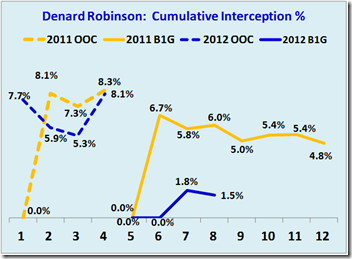 Denard Robinson Interception %: Denard was having a good game until the elbow nerve flared up for the third time this year and he did not return to the game. This is a recurring problem that is not going away and it is very likely that Denard will miss major portions of the next 4 games. The chart shows a comparison of Denard's Int% for 2011 and 2012 subdivided by out-of-conference (OOC) and Big Ten games.
Denard Robinson Interception %: Denard was having a good game until the elbow nerve flared up for the third time this year and he did not return to the game. This is a recurring problem that is not going away and it is very likely that Denard will miss major portions of the next 4 games. The chart shows a comparison of Denard's Int% for 2011 and 2012 subdivided by out-of-conference (OOC) and Big Ten games.
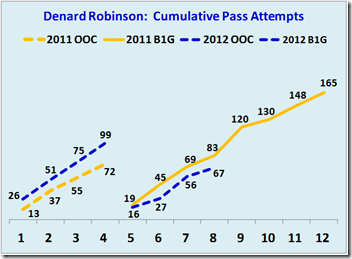 Michigan Football: Michigan had 27 pass attempts and 37 rushing attempts for a 58% run play percentage. Overall M has a 62% run play percentage (ranked #14).
Michigan Football: Michigan had 27 pass attempts and 37 rushing attempts for a 58% run play percentage. Overall M has a 62% run play percentage (ranked #14).
In 2011 M ranked #11 at 65% run play %.
Synopsis for Turnovers: M added 1 interception gained (Ojemudia) for a total of 7 interceptions and is ranked #52. M had one forced fumble (Washington) recovered by Heitzman for 6 fumble recoveries for the year (ranked #63). The total of 14 interceptions lost is ranked at #121. Team interception rate is 7.4% – ranked #124 with the next worst being Auburn at 5.95%. M did not lose a fumble and the total of just 3 lost fumbles is ranked #13. Michigan now has 12 different defensive players that have either forced a fumble, recovered a fumble, or intercepted a pass.
 Synopsis for Expected Point (EP) Analysis: Turnovers
Synopsis for Expected Point (EP) Analysis: Turnovers  resulted in a net of 5.1 expected points benefitting Nebraska. Although the EP analysis does not indicate that TOs were a significant reason M lost this game, my gut sure tells me that the TOs made it just about impossible for M to win this one.
resulted in a net of 5.1 expected points benefitting Nebraska. Although the EP analysis does not indicate that TOs were a significant reason M lost this game, my gut sure tells me that the TOs made it just about impossible for M to win this one.
The folks at Football Outsiders – FEI are also doing weekly "Revisionist Box Scores" that strips out TOs, Special Teams, and Field Position. FEI calculates the value generated by each drive and then lost on the drive up until the turnover, as if the drive had concluded at that spot on the field. Thru Week #8, FEI has 16% of games where TOs were significant.
(See the Section on Gory Details below for how the adjustment for Expected Points (EP) is calculated.)
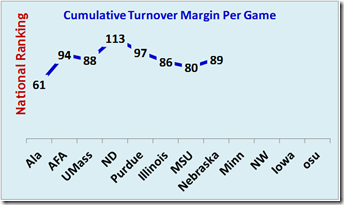 National Rankings: All rankings include games between two FBS teams ONLY and are from TeamRankings except for forced fumbles which is from CFBStats.
National Rankings: All rankings include games between two FBS teams ONLY and are from TeamRankings except for forced fumbles which is from CFBStats.  The four columns with *** show the best correlation to offense and defense (per Advanced NFL stats).
The four columns with *** show the best correlation to offense and defense (per Advanced NFL stats).
The Gory Details
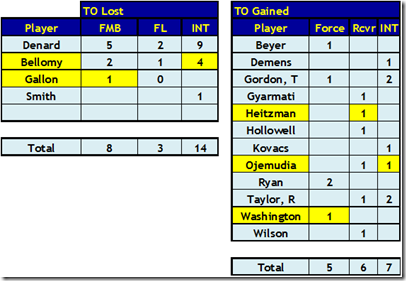 Details for Turnovers: Here is overall summary for all games by player (data in yellow was affected by this week's game).
Details for Turnovers: Here is overall summary for all games by player (data in yellow was affected by this week's game).
Expected Point (EP) Analysis: Basically, the probability of scoring depends on the line of scrimmage for the offense. Therefore, the impact of a TO also depends on the yard line where the TO is lost and the yard line where the TO is gained. Each turnover may result in an immediate lost opportunity for the team committing the TO and a potential gain in field position by the opponent. Both of these components can vary dramatically based upon the down when the TO occurred, the yards the TO is returned, and whether the TO was a fumble or an interception.
Here are the details for the game.
The analysis is a bit tricky because: (A) the TO may directly result in lost EP for the offense but (B) only modifies the EP for the team gaining the TO because the team gaining the TO would have gotten another possession even without the TO (due to a punt, KO after a TD, KO after a field goal, etc.). The Net EP Gain must take into account the potential EP gain without the TO. The EP gain without the turnover is based on where the field position would have been for the next possession if the TO had not occurred.
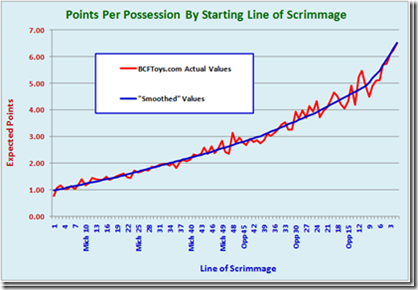 The expected point calculations are based on data from Brian Fremeau at BCFToys (he also posts at Football Outsiders). Fremeau's data reflects all offensive possessions played in 2007-2010 FBS vs. FBS games. I "smoothed" the actual data.
The expected point calculations are based on data from Brian Fremeau at BCFToys (he also posts at Football Outsiders). Fremeau's data reflects all offensive possessions played in 2007-2010 FBS vs. FBS games. I "smoothed" the actual data.
Here is a summary of the smoothed expected points.
October 30th, 2012 at 3:00 PM ^
I really don't see why people are still confused about the Vincent Smith interception. Nobody is saying it was a catch! The rule states clearly that possession must be maintained after going to the ground. There is simply no argument to say that was a catch. The only question is whether the ball hit the ground or not, and therefore whether it was incomplete or not. Since the replays, perhaps due to bad angles, simply do not show the ball hitting the ground, the call on the field stands. Perhaps I'm missing something, but I really don't understand why this is even a thing.
The Roundtree reception is slightly more arguable, with some saying there wasn't enough evidence to overturn the call on the field. That may be true, but since the replay showed the ball moving in his grasp when it hit the ground, it seems to have been the correct call.
The refs were bad, but those two plays are not good examples.
October 31st, 2012 at 10:55 AM ^
I just find it hard to beieve a ball would bounce 5 feet into the air if a player was holding on to it and the ball did not hit the ground!
And, if the catch had not been secured when the ball hit the ground, it was immediately an incomplete pass.
November 2nd, 2012 at 11:00 AM ^
This seems to be the argument, but as I'm sure you'll agree, "I find it hard to believe it didn't hit the ground" isn't exactly a valid criterion for an official sitting in the replay booth.
Not that it matters, but I don't find it hard to believe at all. His hand being under the ball while he's rolling over and getting hit makes a lot more sense to me as the cause of the pop-up than the ball hitting the ground. Footballs don't bounce that high just from hitting the ground.


Comments